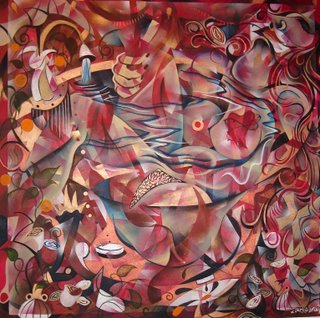Hello Dali
White Space Gallery
1020 Chapel St., 2nd Floor, New Haven, (203) 495-1200
Art Less Ordinary
Ends Nov. 25, 2006.
On the wall facing the door to White Space Gallery hangs a baker's dozen of pencil-signed Salvador Dali lithographs. The selection includes "Fear of Time," a work that features an iconic melting clock. Man, that is so surreal! And it sets something of a tone for the disparate works that comprise Art Less Ordinary.
Limited edition Dali, Joan Miro and Pablo Picasso prints form the core of White Space Gallery's offerings. According to resident artist Denise Parri, the work of these innovative modernists sets the stylistic tone for the gallery: surrealism, Cubism, abstraction.
Parri's own acrylic paintings are pleasing abstractions. The paired "Bronze Wisdom I" and Bronze Wisdom 2" consist of smaller canvases over larger background canvases. The smaller canvases are marked by almost geometric swathes of color. They are treated almost like a faux finish, having a weathered metal appearance similar to bronze or copper that is distressed from exposure to the elements. The background canvases are covered with sketchy swirls of raised lines and combed textures and completed with metallic finishes of bronze or gold. Her "Whispers of Water" is notable for the field of gold leaf over brown paint at the bottom. From the top pigment pours down like a waterfall, fluid streams of green.
Two works by another abstractionist, Christian Miller, are less successful. "Nocturnal Bliss' is very colorful and dotted with numerous pink and white flowers. The flowers, however, seem out of place in a composition that owes more to Jackson Pollock than to Claude Monet. Where "Nocturnal Bliss' is energetic to the point of frenzy, "Separation" is much more staid and controlled. On a brown background that looks almost like suede, there is an interplay of wide, overlapping ribbons. Miller achieves an interesting illusion of depth. The ribbons seem to disappear into the background. Miller effectively incorporates the texture of the canvas into the ribbons. But splotches of green and maroon seem like afterthoughts, as though Miller felt the work was too monochromatic and needed some color variety. The solution here was marred by poor execution. On the limited evidence of these two paintings, Miller is still in search of a personal vision.
In contrast, Molly McDonald's four abstract landscapes do evidence a personal way of seeing. They are marked by a boisterous color application of rich pastels that practically scream summer and the seashore. The concept of "landscape" is used more as a compositional starting point than for purposes of representation.
Hung next to a small Picasso etching, Jack Laroux's "Woman in Rouge B
 ath" is a bracing example of contemporary Cubism. This painting (oil, acrylics and spray paint on canvas) overflows with imagery yet Laroux maintains complete control. And while he wears his influences on his sleeve, his work transcends mere homage. On the other hand, Clinton Deckert's oil paintings—part of his ongoing body of work entitled "Surreal Mindscapes"—seem too much to be surrealism-by-the-numbers, although his technique shows promise. In "Wanderer," a sunflower walks through a Dali-esque barren landscape. "Venus and Luna," a smaller work, pictures the Venus de Milo planted outdoors in a dark blue night illuminated by the moon (with a softly visible and too literal face). Both works are derivative. Deckert would be well advised to follow the lead of Laroux into deeper reaches of his imagination.
ath" is a bracing example of contemporary Cubism. This painting (oil, acrylics and spray paint on canvas) overflows with imagery yet Laroux maintains complete control. And while he wears his influences on his sleeve, his work transcends mere homage. On the other hand, Clinton Deckert's oil paintings—part of his ongoing body of work entitled "Surreal Mindscapes"—seem too much to be surrealism-by-the-numbers, although his technique shows promise. In "Wanderer," a sunflower walks through a Dali-esque barren landscape. "Venus and Luna," a smaller work, pictures the Venus de Milo planted outdoors in a dark blue night illuminated by the moon (with a softly visible and too literal face). Both works are derivative. Deckert would be well advised to follow the lead of Laroux into deeper reaches of his imagination.
Surrealism also seems to be a touchstone for Michael Alfano, a sculptor whose bonded resin works play out as visual puns. The face in "Questioning Mind" is cut in the contours of a question mark; in "Music," the face is in the shape of a G-clef. They are well crafted but somewhat obvious.
And then there are the three paintings by Eduardo Giannattasio, the standout works in this show. Giannattasio, an Italian artist who lives in a 13th-century palazzo, has developed his own signature technique. He first splashes pigment diluted with alcohol on his canvas (actually, in these cases, boards painted white). After the colors drip and blend he selectively sets the canvases on fire. Yes, real fire, as in what your Mom told you not to play with. The flames burn off the alcohol and leave behind attractive burnt scar and smoky effects. The three paintings here, including "Donna in Viola" (see image), were "inspired by the art of seduction," according to his artist's statement. They combine rich liquid colors, singed lines with wisps of smoke and gestural imagery of the female form. The figures are indeed seductive, and nicely set in complementary frames, to boot.
The White Space Gallery is a commercial gallery and there is more on display here, for purchase, than is covered in this review. And if some of what makes up this show is art more ordinary, the paintings by Giannattasio and Laroux certainly live up to the title. You have until Nov. 25 to see these works but remember—the clock is melting.

0 Comments:
Post a Comment
<< Home